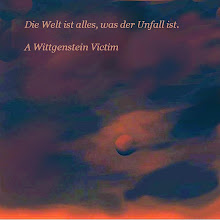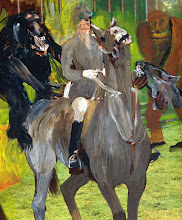If the Enlightenment was the Age of Reason, we are living in a new Baroque
Age of the Body. Wittgenstein was one of its early thinkers. With his radical
discovery – ‘Philosophy is dead! Everything is allowed!” – he liberated
philosophy from the burden of truth and logic. Philosophy could become
businesslike and insincere. Some today like Alain Badiou profess to bring back
truth, but it’s not the same. History is truly irreversible. You can never go
home again. Not only is philosophy dead, the Critic is also an anachronism, as the Futurists already declared. The Critic discloses the ‘behind the scene’ – but the behind has collapsed. All that remains is inside the Scene. ‘Outside’ is a fatal illusion sustained by the world of action. Everywhere is anywhere and it all looks alike. There is no way out and no way in.
A similar time was the Baroque. The forms of the Baroque are hermetic and
all on the surface. They envelop and enclose.
1.
Aesthetic Pain – New Baroque
If quantity were not in itself a pain, why would one attempt to soothe it by
allowing for inexactitude? But is exactitude only to be found in quantity? One
cannot escape quantity by being inexact – the quantity in its real state is not
less because it is represented inexactly. Exactitude and inexactitude are found
in language and other systems of measurement, like truth and falsehood. The
false scale. Quantity has the rhythm of monotony. The constancy of quantity
is its quality. This is a source of pain. To exactly follow a rule is not
necessarily a question of quantity – a rule can be ‘broken’ in an unknown
number of ways, none of which need be numerical. The way to guarantee the
least inexactitude in following the rule is to diminish the gap between the
rule/order and obedience to it. The gap should aspire to zero. The rule and
the following of the rule should be nearly identical. Closeness of the rule to
the following of it is the primary quality of the rule. It is the same closeness as
in the monadic enclosure. This is also a way of defining baroque art or
aesthetic – the least possible distance to the object. The romantic aesthetic or
poesis is seemingly opposed to this baroque adhesiveness of the vision and the
visible – the romantic perspective is a function of distance and the poetic
elevation of an object by moving away from it. The idea of distance:
everything seen from a distance is gilded in mystery, poetry. When distances
fade or disappear, what sort of state sets in? Threat and prose – that which
seems unavoidable.
The baroque body or ‘bare life’ does not follow the rule-law, he is the body of the law.
The gap or void between the rule and obeying the rule is closed or filled in by
the body. This recalls the baroque “allegorizing of the physis”(Benjamin) in
the tragedies of the martyr-tyrant. The tyrant who has been the law of
absolute power remains that law as martyred corpse. As a live tyrant or dead
martyr – he is the indissoluble unity of body and law. Agamben’s prime
example of the gapless unity of rule and obedience is the Führer’s voice. All of
Wittgenstein’s rule dilemmas seem to be resolved in Agamben’s double-bodied hybrid of the baroque tyrant-martyr and the Nazi Führer – and in their alleged mirror image, ‘homo sacer’.
For the Renaissance tyrant or prince, cruelty or pain is a calculated means of
power, of obtaining it, keeping it. Pain is a necessary evil as is punishment.
He thinks like an ancient Chinese philosopher of warfare – power is not a gift of the gods; it must be endlessly studied and evaluated. For the baroque
ruler cruelty or pain is a value in itself – as a way to obtain holiness, as a
source of lust and desire, as the exuberance, superabundance and privilege of
power. Being is that which is there (ready to hand) for an audience. The more
aesthetic Being is, the more it is there for an audience. The Body of Pain (the
world of the unhappy) is Being which is more than just for itself; it is Being
whose very passivity (powerlessness) metamorphoses through martyrdom into dramatic action. Pain has the quality of concentrating all of Being in itself as affect. The drama of martyrdom – pain for an audience – is the unity of the body of grammar and the body of pain. Pain is itself and its own allegory. This is an axiom of baroque aesthetics. In the drama of baroque martyrdom the nothing of powerlessness turns through pain into the everything of power.
Pain is aesthetic, pleasure is domestic. Martyrdom is the affirmation of pain.
The affect of pain, the propensity to suffer, as part of the sentient human
biology, carries within it the potential transcendent plane – transcendence
is rooted in the biological organism, not in the ‘soul’. The allegorical ‘surplus’,
the remainder of martyrdom is the emblematic corpse.
The German romantics rediscovered this baroque sensibility – as Novalis wrote: “It is curious that the association of sexual pleasure, religion and cruelty has not long since caused people to notice their close relationship and their common tendency.”(Die Enzyklopädie, Werke und Briefe, Stuttgart, 1962, p.493)
Ecstasy is a state of being like beatitude belonging neither to pain nor to
pleasure. It goes beyond both, it can blot out pain for its duration and
individual pleasure vanishes in it like a ray of light in the sun. It is a fragment of something infinite. Ecstasy is neither pain nor pleasure, public nor private. Although perhaps real ecstasy can only be experienced en masse - when the percipient individual is already dissolved into an indistinguishable collective or multitude.
Ecstasy is one of those Unnameables, Being which is beyond
language, the magic prison of the Social. One knows ecstasy is real because
afterwards it names its sudden price. In the legends of the saints the body is
made to suffer for the soul – even without a belief in the transcendent soul,
surely it cannot just be the body wanting to suffer for the — body?
2.
When a Cold Pervert Turns into a Hot Pervert
Perversion as a literary mood might be classified as either hot or cold.
Bataille is a hot pervert, addicted to cruelty and sex exuding from waste and excess whereas cold perverts like Burroughs favor a certain kind of businesslike efficiency based on opiated sloth. Bataille for instance was fascinated by photos of Chinese victims of Ling Chi, the slow slicing torture (‘death by a thousand cuts’), a form of execution reserved for those convicted of high treason or people who murdered their parents - considered low treason.
But when the cold pervert Burroughs turns into a hot pervert in Nova Express towards the end or already at the beginning he gets very hot – hotter even than a hot pervert like Bataille. In “Pry Yourself Loose and Listen” – everything is very hot. Hot Hitler, hot Hitler ovens, hot nova ovens, hot Hiroshima and Nagasaki, hot Venus – then the two hot Nova characters conjure up a “Mayan Aztec God” called the “Mayan God of Pain and Fear” who threatens the conjurors who are too hot to notice – that they can’t pay him enough for his Name. “Remember we keep exact junk measure of the pain inflicted and that pain must be paid in full.” (Nova Express, 1964) The only way to cool down in Nova is on a cold jissom morning. What is the ontology of jissom? A dying word?

















.jpg)














No comments:
Post a Comment